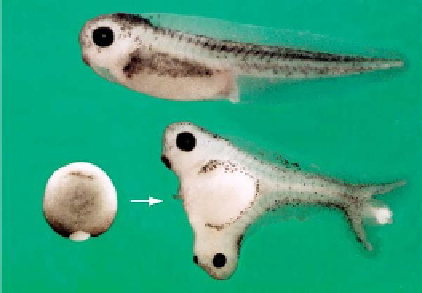Biology Reference
In-Depth Information
Figure 3.14
The Spemann-
Mangold organizer experiment in
1924.
Source
: From
De Robertis (2006)
.
discovered that amphibian embryos have an “Organisator Region,” whose transplan-
tation to other parts of another embryo induced the formation of a secondary embry-
onic axis. They coined the term
induction
to describe such signaling from a group of
cells and its morphogenetic effects on another group of cells. The work won him (his
young collaborator died accidentally just before the publication of the article) the
1935 Nobel Prize for Medicine and Physiology. He also developed the first nuclear
transfer method actually used in cloning experiments: he transferred the nucleus of
an early (16-cell) embryo to an enucleated salamander embryo cell, which developed
into an adult salamander. His successful transplantation of the cell nucleus to an egg
heralded the advent of experimental cloning by the nuclear transfer method.
This is a classic experiment because of its elegance and importance in experimen-
tal and theoretical developmental biology, and it still remains, in De Robertis and
Wessely's expression, the “Holy Grail of experimental embryology” (
De Robertis
and Wessely, 2004
).
Spemann's organizer synthesizes a number of neuralizing factors and antagonists
of Wnts, especially BMPs secreted by the ventral center, thus enabling the dorsal
side to adopt the default neural fate, but Spemann's organizer itself is an epigeneti-
cally induced structure:
The organizer
…
is formed in the blastula stage of the amphibian embryo by cells
that have responded to two maternal agents: a general meso-endoderm inducer
(involving the TGF-beta signaling pathway) and a dorsal modifier (probably involv-
ing the Wnt signaling pathway).
Harland and Gerhart (1997)
Formation of Embryonic Germ Layers
In
Xenopus
, gastrulation leads to the formation of three embryonic layers and the
establishment of definitive anteroposterior and dorsoventral axes (Birsoy et al., 2006).

Search WWH ::

Custom Search